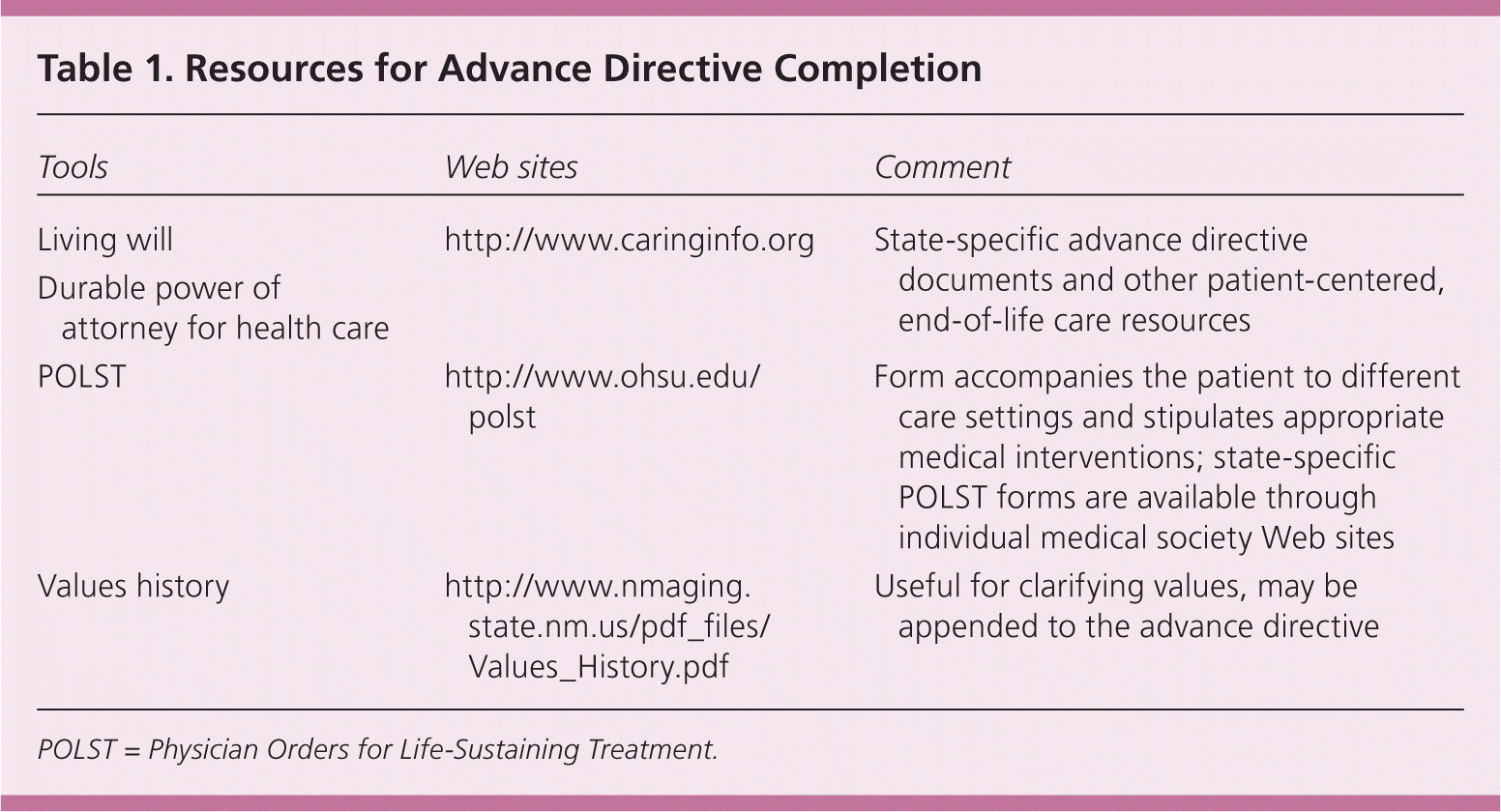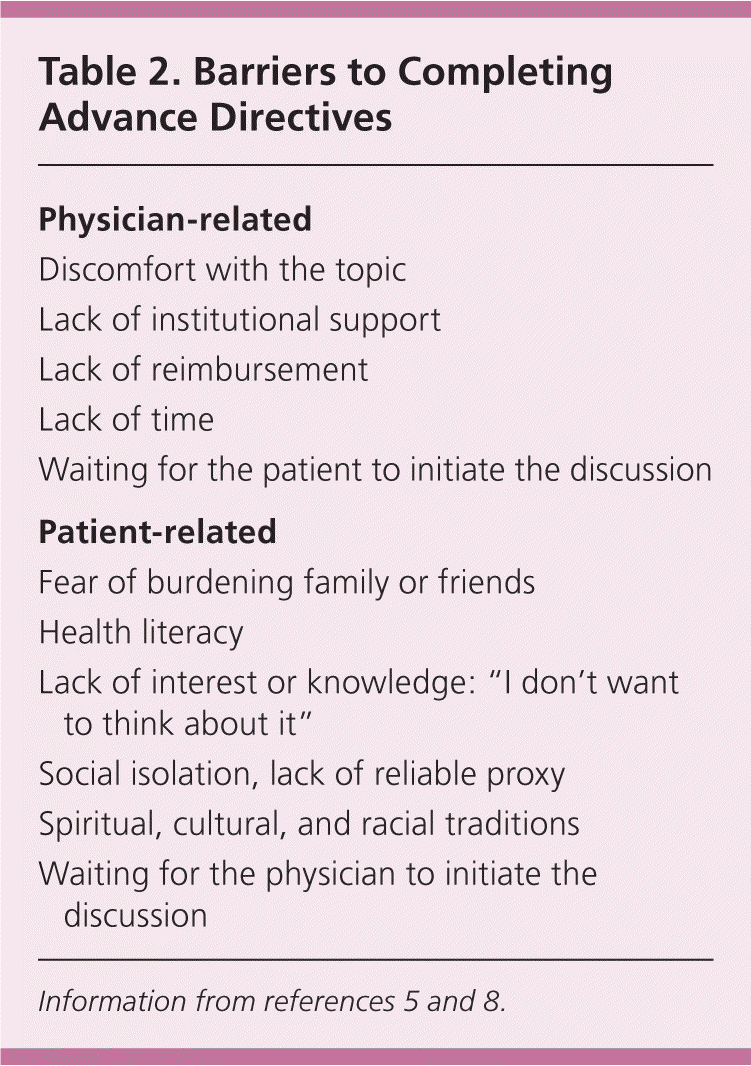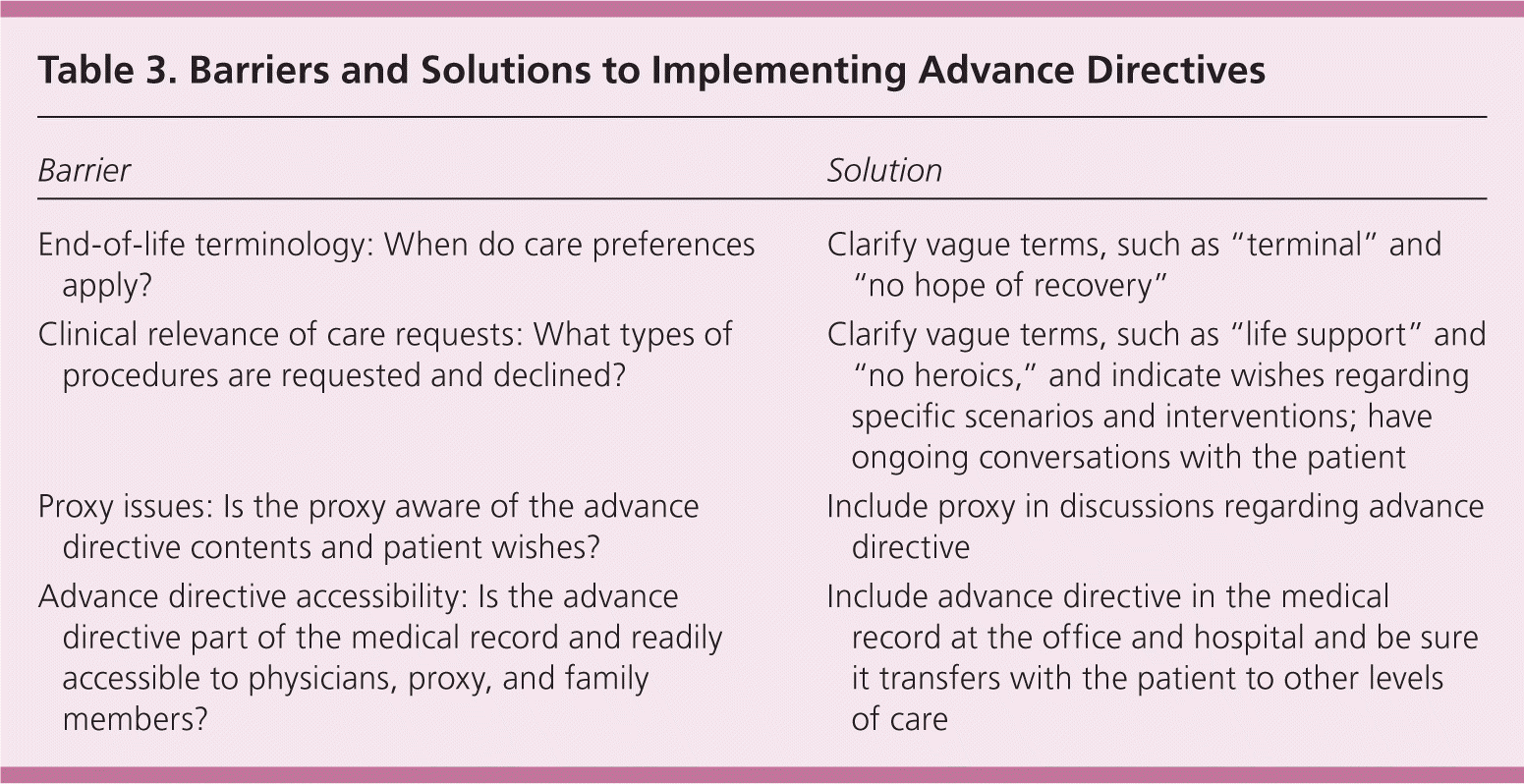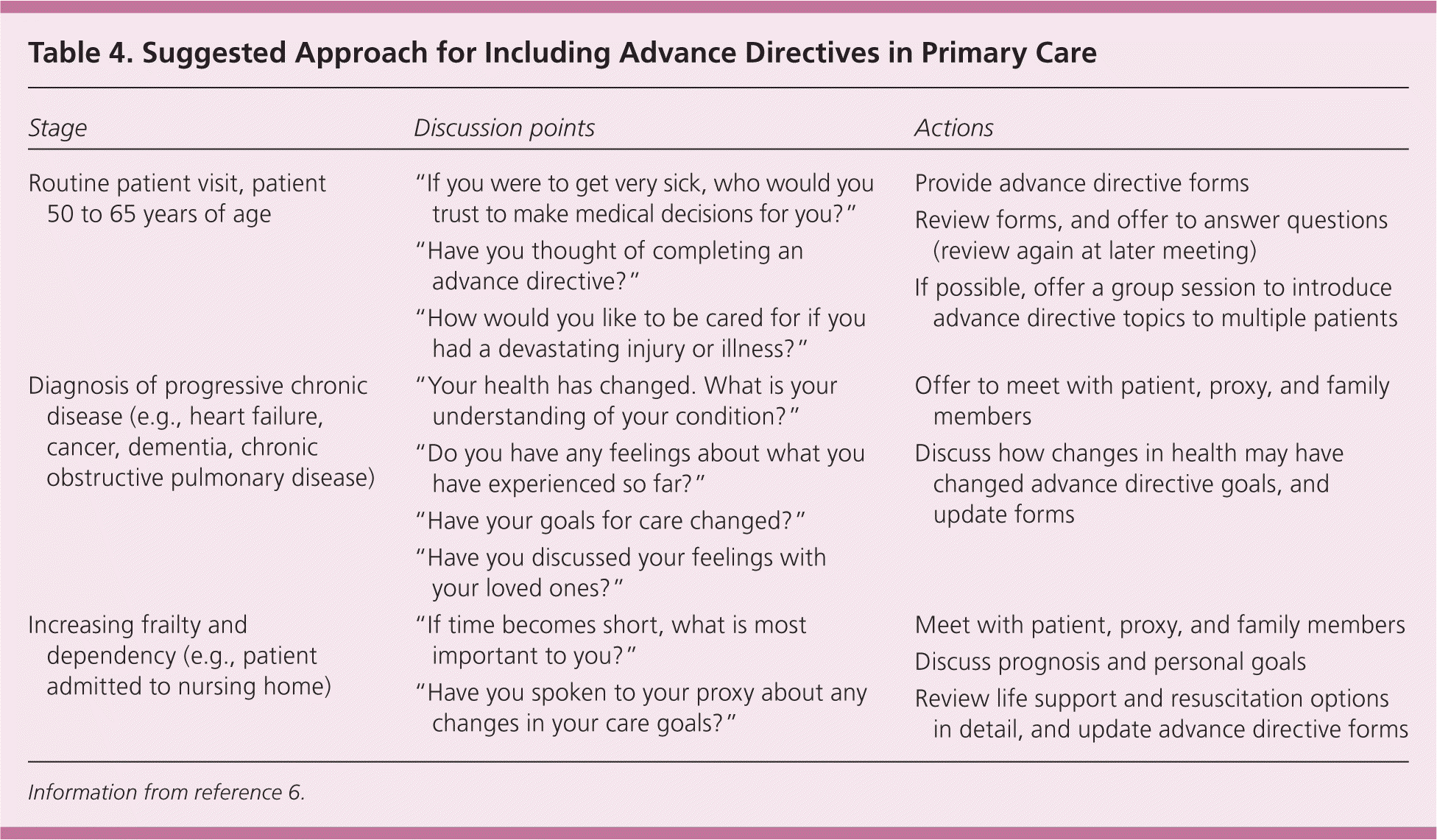
Am Fam Physician. 2012;85(5):461-466
Related letter: Strategy for Facilitating Advance Directive Completion Among Patients
Patient information: See related handout on advance directives, written by the authors of this article.
Author disclosure: No relevant financial affiliations to disclose.
Patients prepare advance directives in an effort to maintain autonomy during periods of incapacity or at the end of life. Advance directive documents are specific to the state in which the patient lives, but an effective strategy in the family physician's office involves more than filling out a form. Physician barriers to completing an advance directive include lack of time and discomfort with the topic. On the patient's part, lack of knowledge, fear of burdening family, and a desire to have the physician initiate the discussion are common barriers. Once the advance directive is complete, barriers to implementation include vague language, issues with the proxy decision maker, and accessibility of the advance directive. Overcoming these barriers depends on effective communication at multiple visits, including allowing the patient the opportunity to ask questions. Involving the family or a proxy early and over time can help the process. It may be helpful to integrate advance directive discussions at selected stages of the patient's life and as health status changes.
The concept of advance directives is rooted in the ethical principle of patient autonomy. By formally specifying care preferences (living will) and/or naming a proxy for making health care decisions (durable power of attorney for health care), patients can maintain more autonomy during periods of incapacity and at the end of life. Oral statements are recognized ethically, and in some states legally, if properly documented. The documents associated with an advance directive are state-specific, and physicians need to be familiar with the applicable laws in their area.1–3 In many cases, care preferences and appointment of a proxy are included in the same document. Table 1 provides links to example documents and other resources related to advance directives.
| Clinical recommendation | Evidence rating | References | Comments |
|---|---|---|---|
| The most effective advance directive interventions involve interactive discussions between the patient and physician over multiple visits. | C | 8, 25, 26 | Systematic reviews |
| Repeated advance directive discussions relevant to the patient's life stage may help improve advance directive completion and appropriate implementation. | C | 6, 29 | Expert consensus |
| Advance directive discussions with the patient and family that emphasize goals of care improve end-of-life care, patient satisfaction, and family stress. | B | 32 | Prospective, randomized controlled trial |
| Systematic use of specific physician orders regarding life-sustaining procedures is associated with a reduction in undesired medical interventions in nursing home patients. | C | 35 | Retrospective observational cohort study |

| Tools | Web sites | Comment |
|---|---|---|
| Living will | http://www.caringinfo.org | State-specific advance directive documents and other patient-centered, end-of-life care resources |
| Durable power of attorney for health care | ||
| POLST | http://www.ohsu.edu/polst | Form accompanies the patient to different care settings and stipulates appropriate medical interventions; state-specific POLST forms are available through individual medical society Web sites |
| Values history | http://www.nmaging.state.nm.us/pdf_files/Values_History.pdf | Useful for clarifying values, may be appended to the advance directive |
The federal Patient Self-Determination Act of 1990 requires hospitals, nursing homes, and other facilities to provide information about advance directives to patients and to keep a record of any completed documents. Regardless of the implementation of these regulations, the rate of advance directive completion has been disappointing, and their value has been questioned.3–6 A report to Congress highlighted several problems with the customary advance directive process and made recommendations for improvement, most centering on improved communication between the physician and patients and their families.7
Barriers to Completion
Studies focusing on methods to improve rates of advance directive completion have identified several potential barriers (Table 2).5,8 Physician barriers are often related to lack of time and reimbursement.5,8 Reviewing advance directives in the office setting may require 30 minutes, or more if the physician meets with the proxy and family members.3 Billing for this service may also be problematic. Some physicians are uncomfortable with the topic and prefer to wait for the patient to raise the issue.8

| Physician-related |
| Discomfort with the topic |
| Lack of institutional support |
| Lack of reimbursement |
| Lack of time |
| Waiting for the patient to initiate the discussion |
| Patient-related |
| Fear of burdening family or friends |
| Health literacy |
| Lack of interest or knowledge: “I don't want to think about it” |
| Social isolation, lack of reliable proxy |
| Spiritual, cultural, and racial traditions |
| Waiting for the physician to initiate the discussion |
Patient barriers are more varied. Studies show that lack of interest or knowledge is common,8–10 whereas current health status does not correlate with advance directive completion.9 Some patients fear burdening family or friends, even though an advance directive can relieve uncertainty about care preferences.10 In some cases, social isolation or lack of an available proxy is an issue. Most patients expect the physician to bring up the topic.8
Cultural, racial, and ethnic factors also play a role in advance directive completion. Black patients are less likely to complete advance directives and are more likely to prefer aggressive care until the end of life. They are also more likely to cite communication problems with their physicians. Hispanic and Asian patients more often rely on family members for decisions rooted in tradition and spiritual beliefs and thus may not believe that an advance directive is needed.11–15 However, there is considerable overlap in attitudes among ethnic and racial groups, and it is important not to stereotype patients.
Barriers to Implementation
Although recent studies affirm the benefits of advance directives in terms of receiving care congruent with patient preferences,16–18 several problems with implementation have been identified (Table 3). The language used in the documents can be a major barrier to implementation. In designating when to implement the advance directive, patients often use terms such as “terminal” and “no hope of recovery,” leaving questions regarding what specific situations would apply. Treatment preferences are also sometimes expressed in unclear terms, such as “no heroics.”19 A useful advance directive describes specific clinical situations in which the document should apply (e.g., stroke with disability, cancer with metastasis, cardiac arrest) and the types of care desired or declined (e.g., cardiopulmonary resuscitation [CPR], enteral feedings, intubation and mechanical ventilation). It is important to note that ill patients may change preferences for or against life-sustaining treatments as their condition worsens.20

| Barrier | Solution |
|---|---|
| End-of-life terminology: When do care preferences apply? | Clarify vague terms, such as “terminal” and “no hope of recovery” |
| Clinical relevance of care requests: What types of procedures are requested and declined? | Clarify vague terms, such as “life support” and “no heroics,” and indicate wishes regarding specific scenarios and interventions; have ongoing conversations with the patient |
| Proxy issues: Is the proxy aware of the advance directive contents and patient wishes? | Include proxy in discussions regarding advance directive |
| Advance directive accessibility: Is the advance directive part of the medical record and readily accessible to physicians, proxy, and family members? | Include advance directive in the medical record at the office and hospital and be sure it transfers with the patient to other levels of care |
Proxy decision makers are expected to use substituted judgment that relies on the patient's expressed wishes. When the proxy is unaware of the patient's wishes, decisions should be based on the patient's best interests. However, many patients give the proxy considerable latitude in making decisions because it is difficult to predict future clinical situations and treatment options.21 It has been shown that proxies are more accurate in predicting a patient's wishes than physicians are, although proxies could misinterpret the patient's wishes and substitute their own values.22 A recent meta-analysis shows that proxy decision makers often experience considerable stress, which is mitigated by the presence of advance directives.23
Because treatment decisions may be made in an urgent situation, immediate access to the advance directive is essential to its implementation. However, many patients fail to distribute copies to their physician, proxy, or family members. Additionally, the document may not accompany the patient when he or she is transferred to different care settings, such as the hospital or nursing home. In the absence of an advance directive, the health care team may feel pressured to provide care based on the demands of the most vocal family member, which may not be the patient's wish.3,4 The physician providing continuity of care is well positioned to ensure that the advance directive is available and implemented.24 Additionally, electronic health records provide an opportunity for improving accessibility to advance directives.7
Approaches for Improving Completion and Implementation
Two systematic reviews provide useful insights into interventions that may increase advance directive completion rates.25,26 Interactive interventions, which provide opportunities to ask questions and receive assistance from a knowledgeable person, were shown to be more effective than didactic interventions, which provide education in the form of a program, clinical encounter, or mailing.25 The most successful interactive interventions include repeated conversations about completion of advance directives over time.26 Group-based interactive interventions are more effective than individualized interventions, suggesting that it is beneficial to have the information presented in a setting that stimulates group discussion and generates more questions.25
Most research on improving the completion rate and quality of advance directives uses the health behavior change model.27 Emphasis is placed on identifying barriers specific to the individual patient and using a stepwise approach to overcome those barriers.8,11 Repeated discussions about care goals, which can change as the patient becomes increasingly frail or the disease progresses, may help improve advance directive completion and appropriate implementation.6,28,29 Articles have reviewed guidelines for successful communication and important pitfalls to avoid during end-of-life discussions.24,30 The physician's ability to facilitate involvement of the family and proxy early and over time may be key to a successful advance directive.5,8,21
Improving advance directive implementation requires more than a didactic intervention after the patient becomes ill. A study of intensive education for physicians and patients regarding prognosis and functional outcomes of treatment options (e.g., CPR) in teaching hospital settings failed to show improvement in the quality of end-of-life care or outcomes.31 However, more recent research shows that emphasizing goals of care in advance directive discussions with the patient and family improves end-of-life care, patient satisfaction, and family stress.32 A values history document may be appended to an advance directive to help guide difficult care decisions and make them more reflective of the patient's goals and priorities.33
For patients who have progressive chronic illness or frailty, the Physician Orders for Life-Sustaining Treatment (POLST) document is an attempt to address vague language and lack of portability. It has been adopted in varying forms in several states.34 The POLST document is signed by the physician, accompanies the patient between care settings, and stipulates the medical interventions appropriate for that patient. Use of the POLST document has been shown to decrease the likelihood of receiving undesired medical interventions in nursing home patients and to improve the frequency of life-sustaining treatment beyond CPR.35
The Respecting Choices program is an educational process focus improving advance directive completion and implementation at the community level.36 The intervention is staged according to the patient's age and health status and uses trained nonphysician facilitators.37 The program has achieved a 90 percent advance directive completion rate, and has been shown to ensure patient care that is consistent with advance directives and to decrease caregiver stress, anxiety, and depression.32,38 The involvement of facilitators has been shown to be effective in improving the proxy's understanding of the patient's goals, thus improving outcomes consistent with patient wishes.39 However, this program needs further dissemination and validation.
A Suggested Approach for the Primary Care Physician
A clinical approach that is appropriate to the patient's life stage may foster effective and interactive advance directive discussions (Table 4).6 The first phase occurs between 50 and 65 years of age in the physician's office at the time of a routine checkup. The physician should initiate a basic advance directive discussion along with discussions about preventive issues, such as colorectal cancer screening. The discussion is readdressed at subsequent health maintenance visits. One study shows that mailing an advance directive form to the patient ahead of the appointment improves completion rates compared with using computer-generated physician reminders.40

| Stage | Discussion points | Actions |
|---|---|---|
| Routine patient visit, patient 50 to 65 years of age |
|
|
| Diagnosis of progressive chronic disease (e.g., heart failure, cancer, dementia, chronic obstructive pulmonary disease) |
|
|
| Increasing frailty and dependency (e.g., patient admitted to nursing home) |
|
|
The next phase occurs when the patient experiences a chronic and progressive illness. Following a realistic discussion of the patient's prognosis, the physician initiates a more in-depth discussion, including the proxy and family members as desired, that centers on the patient's care goals. Adding a values history to the advance directive may be helpful. After the discussion, the advance directive is updated and made as specific as possible. These issues should be readdressed periodically and as circumstances change.
The last phase occurs with the onset of frailty or the need for long-term care. The discussion, centered on the patient's care goals, may result in consistent and specific physician orders regarding life-sustaining interventions.
